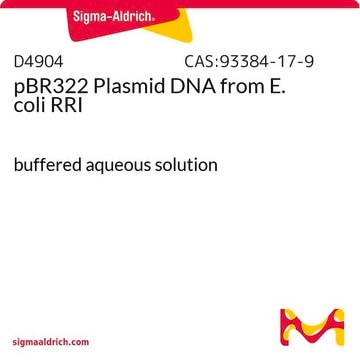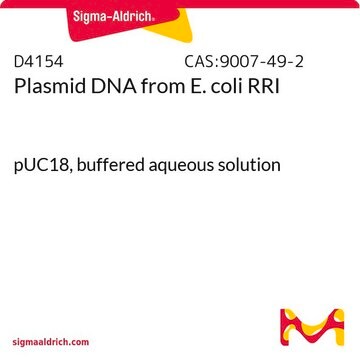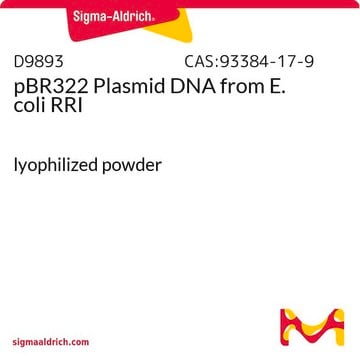D3404
Plasmid DNA from E. coli RRI
pUC19, buffered aqueous solution
About This Item
Productos recomendados
grade
for molecular biology
form
buffered aqueous solution
shipped in
dry ice
storage temp.
−20°C
InChI
1S/C15H31N3O13P2/c16-13-1-7(20)11(28-13)5-25-32(21,22)31-9-3-15(18)29-12(9)6-26-33(23,24)30-8-2-14(17)27-10(8)4-19/h7-15,19-20H,1-6,16-18H2,(H,21,22)(H,23,24)
InChI key
AWBASQCACWFTGD-UHFFFAOYSA-N
¿Está buscando productos similares? Visita Guía de comparación de productos
General description
Application
Biochem/physiol Actions
Foreign DNA inserted at the MCS abolishes the ability to catabolize lactose. Lactose-positive, ampicillin-resistant colonies (host strain containing plasmid) form blue colonies on plates containing ampicillin and X-Gal; lactose-negative, ampicillin-resistant colonies (host strain containing plasmid with foreign DNA inserted at the MCS) form white colonies on this medium. The orientations of the MCS regions in the pUC plasmids are analogous to those of the corresponding M13 phage.
Components
Principle
Related product
Storage Class
10 - Combustible liquids
wgk_germany
WGK 1
flash_point_f
Not applicable
flash_point_c
Not applicable
Certificados de análisis (COA)
Busque Certificados de análisis (COA) introduciendo el número de lote del producto. Los números de lote se encuentran en la etiqueta del producto después de las palabras «Lot» o «Batch»
¿Ya tiene este producto?
Encuentre la documentación para los productos que ha comprado recientemente en la Biblioteca de documentos.
disturbance suppression for nanostructure
imaging
Protocolos
Preparation for biodegradable nanoparticles and their use in transfection protocols .
Nuestro equipo de científicos tiene experiencia en todas las áreas de investigación: Ciencias de la vida, Ciencia de los materiales, Síntesis química, Cromatografía, Analítica y muchas otras.
Póngase en contacto con el Servicio técnico







